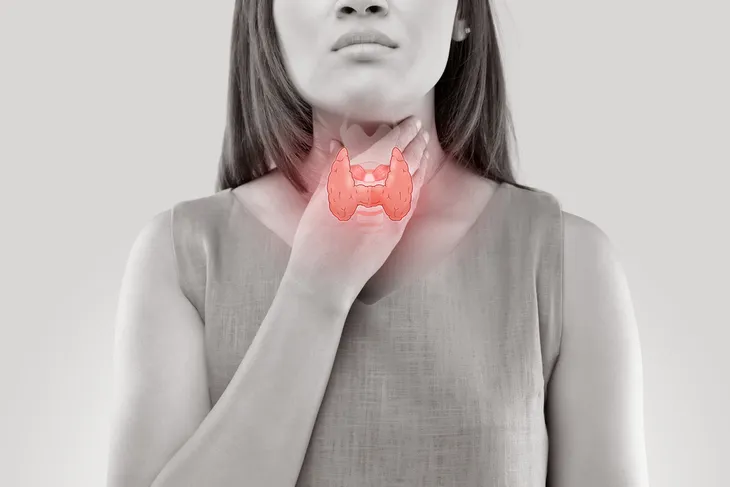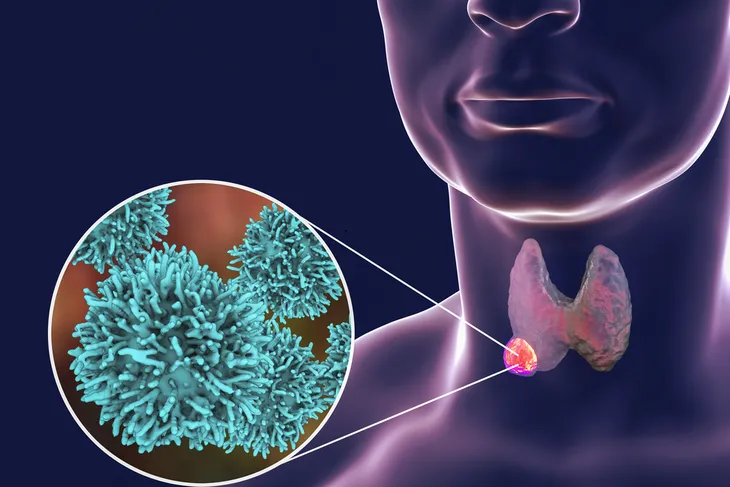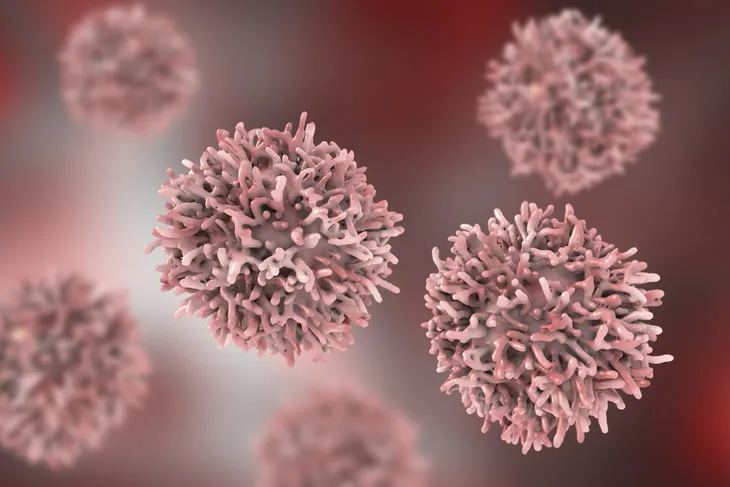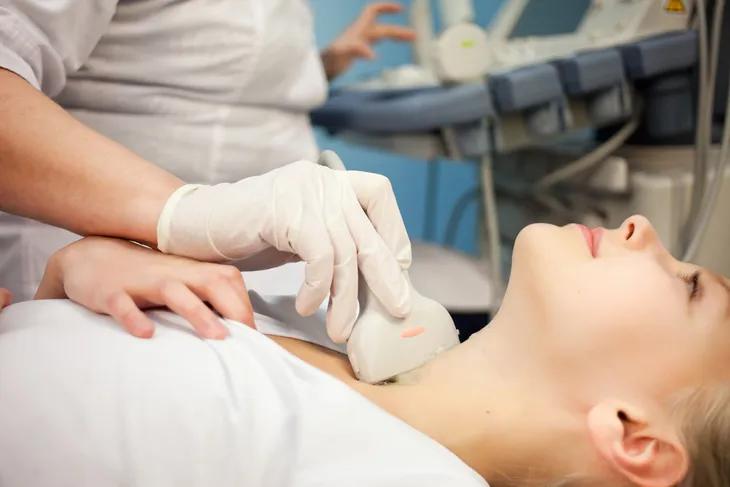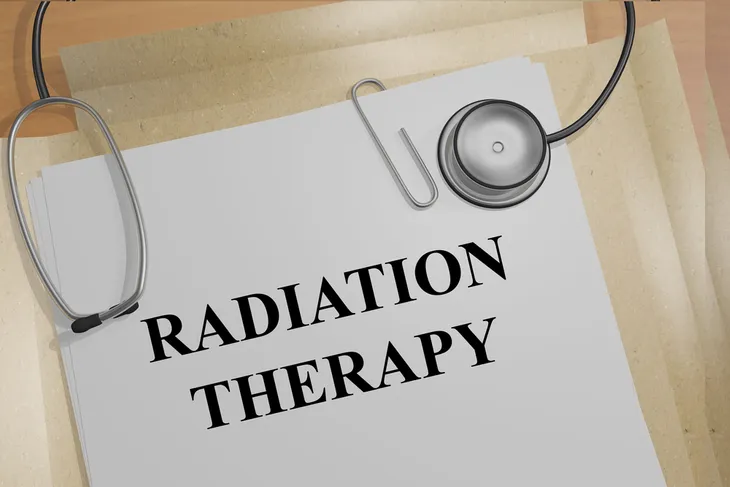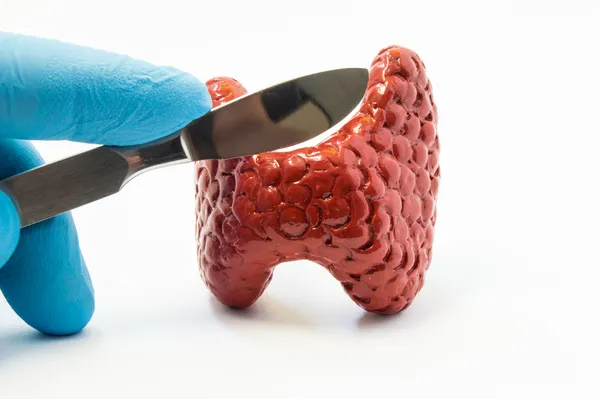Even though we can’t see our thyroid and it’s relatively small, it has a really important job. The thyroid produces hormones that regulate important body functions, such as heart rate, blood pressure, body temperature, and weight. This butterfly-shaped gland is located at the base of the neck, just below the Adam’s apple. While thyroid cancer isn’t all that common in the U.S., according to the Mayo Clinic, the number of cases in the U.S. is on the decline; it’s still an important cancer to be wary of.
So, let’s take a look at some of the most important things to know about thyroid cancer including the different types, symptoms, causes, and treatments.
What Is the Thyroid Gland?
We’ve all heard of our thyroid gland, but when we stop to think about it, do we actually know what it is? The thyroid gland consists of two lobes that are located on either side of the windpipe. It plays an important role in our overall health as it releases three different types of hormones into the body that affect many different functions of the body.
The three hormones that are released by the thyroid gland include triiodothyronine (T3) and thyroxine (T4), which work to regulate the body’s metabolic rate. It controls how the body processes calories and how quickly they are burned off. So, an excess of these hormones, or lack of, can cause a person to feel sluggish, gain weight, or lose weight. The other hormone is calcitonin which affects our bone strength by controlling calcium levels. This hormone doesn’t have as big of an impact because the body has other ways of controlling calcium.
Papillary Carcinoma
Papillary carcinoma is a differentiated form of thyroid cancer (DTC), also sometimes referred to as well-differentiated (WDTC). It is the most common kind of thyroid cancer. The name well-differentiated comes from the fact that these cancerous cells still resemble healthy cells, but they originate from the follicular cells of the thyroid, says Thyroid Cancer Canada. It accounts for over half of the cases (about 60-percent, according to the NHS), and typically affects women under the age of 40.
WebMD describes it as growing slowly, but it will eventually spread to the lymph nodes of the neck. The source also says that most people who are diagnosed with this type of thyroid cancer have a good chance at full recovery.
Follicular Carcinoma
Follicular carcinoma is another common type of thyroid cancer, but it is not nearly as common as the first. It often results from a lack of iodine, so it’s more common in countries where people are more likely to suffer from an iodine deficiency. It affects 3 out of 20 cases, which translates to about 15-percent, writes the NHS.
This type of cancer tends to target older adults and can spread to the lungs and bones. According to the American Cancer Society, the prognosis of this cancer isn’t as great as papillary thyroid carcinoma, but it’s still treatable.
Medullary Thyroid Carcinoma
The third type of thyroid cancer is known as medullary thyroid carcinoma (MTC) which accounts for only about 5 to 8-percent of diagnosed cases, says the NHS. This is about 5 or 8 out of every 100! Unlike the other cases on this list, this type of thyroid cancer is genetic and tends to run in families. WebMD notes that it tends to be found at an early stage because it produces the hormone calcitonin, which will show up in many doctor-prescribed blood tests.
The American Cancer Society explains that there are two types of MTC: sporadic MTC and familial MTC. Sporadic MCT is more common, as it accounts for about 80-percent of all medullary thyroid carcinoma cases and is not inherited. The source notes that it typically occurs in older adults and will only target one of the thyroid lobes. On the other hand, familial MTC is an inherited cancer and there’s a 20 to 25-percent chance it will occur in each generation of a family. “These cancers often develop during childhood or early adulthood and can spread early. Patients usually have cancer in several areas of both lobes,” says the American Cancer Society.
Anaplastic Thyroid Carcinoma
This type of thyroid cancer is extremely rare and the most aggressive. Unfortunately, it’s also the hardest to treat. It is typically seen in older adults who are over the age of 60 and accounts for about 2-percent of all thyroid cancers. “It is thought to sometimes develop from an existing papillary or follicular cancer. This cancer is called undifferentiated because the cancer cells do not look very much like normal thyroid cells under the microscope,” writes the American Cancer Society.
Diagnosis
After a physical exam is performed, the least invasive way to make a diagnosis is through a blood test. This will measure the level of hormones in the blood and either confirm or rule out whether or not the patient is suffering from other thyroid problems. If nothing is found, the Canadian Cancer Society explains several other options, including radioactive iodine tests, ultrasound, biopsy, computed tomography (CT) scan, magnetic resonance imaging (MRI), chest X-ray, and even a positron emission tomography (PET) scan.
The most likely next step would be to do an ultrasound and then possibly a biopsy of the lump. This will be performed by fine-needle aspiration (FNA), where a thin needle is used to remove a small amount of fluid or cells from the lump, or a doctor could perform a core biopsy, which is similar but uses a hollow needle to probe and remove a piece of tissue to be examined under a microscope.
Signs and Symptoms
Thyroid cancer is tricky because it doesn’t always present many signs or symptoms right away, so it often goes undetected in the early stages. As it grows, it will begin to produce more symptoms. WebMD lists the following symptoms as the most common: “neck, throat pain, lump in your neck, difficulty swallowing, vocal changes, hoarseness, and cough.”
The American Cancer Society says any person who is showcasing these signs should seek medical attention right away. The source notes that the symptoms above “can also be caused by non-cancerous conditions or even other cancers of the neck area.” While lumps in the thyroid are usually benign, if it is accompanied by any of the listed symptoms, it’s better to be safe than sorry.
Cause: Gender and Age/Hereditary Genetics
While there aren’t any clear or definitive causes for thyroid cancer, in some cases, the cancer can be traced back to a person’s DNA, which means it was inherited from their parents. WebMD points out that MTC is a result of an abnormal gene that is passed down through family genetics.
Thyroid cancer is also more common in women than it is in men, especially females who are in their 40s and 50s. Men, on the other hand, are more at risk in their 60s. “Follicular thyroid cancer happens more often in whites than blacks and in more women than men. You can still get thyroid cancer if you’re younger. Papillary thyroid cancer, for example, happens most often in people between ages 30 and 50,” writes WebMD.
Cause: Iodine Diet
Another risk factor for thyroid problems is a lack of iodine or an iodine deficiency. People who do not get enough iodine could be more at risk for developing certain types of thyroid cancer. This cause is extremely rare because most people in America get plenty of salt in their diet since it is added to many processed foods.
Cause: Radiation Exposure
Someone who was previously exposed to radiation treatment near their head and/or neck could be at a higher risk for developing thyroid cancer, says WebMD. According to the Mayo Clinic, an example of exposure to radiation would be “radiation treatments to the head and neck and fallout from sources such as nuclear power plant accidents or weapons testing.”
Treatment: Surgery
As with many other cancers, the form of treatment depends on how advanced the cancer is, in other words, the stage and type of thyroid cancer. One of the most common forms of treatment is surgery. People who are suffering from thyroid cancer will undergo surgery to remove part of or most of their thyroid. Most cases undergo a complete thyroidectomy, assuring doctors all the cancer is gone. This will leave a small incision at the base of the neck. The surgeon could also choose to remove the lymph nodes in the neck to test them for cancer, says the Mayo Clinic.
If the cancer is very small, the doctor might choose to only remove part of the thyroid (thyroid lobectomy). This would result in the surgeon removing only one side of the thyroid.
Treatment: Therapy
There are several forms of “therapy” when it comes to treating thyroid cancer. The first is hormonal therapy, which is used after a lobectomy. This will ensure the body still receives the hormones it would normally get if the thyroid hadn’t been removed. It also suppresses the production of thyroid-stimulating hormone (TSH), which could encourage more cancer growth.
Other forms of therapy are radiation therapy, with the most common being radioactive iodine therapy. Radiation is used after surgery to “kill any cancer cells and normal thyroid tissue that remain in the body and treat cancer that has spread to lymph nodes or other parts of the body,” says the Canadian Cancer Society. There is also targeted therapy, which can be used “to treat advanced or metastatic differentiated thyroid cancer when radioactive iodine therapy hasn’t worked,” and chemotherapy, which isn’t often used for thyroid cancer, but can be used to relieve symptoms or treat anaplastic carcinoma.

